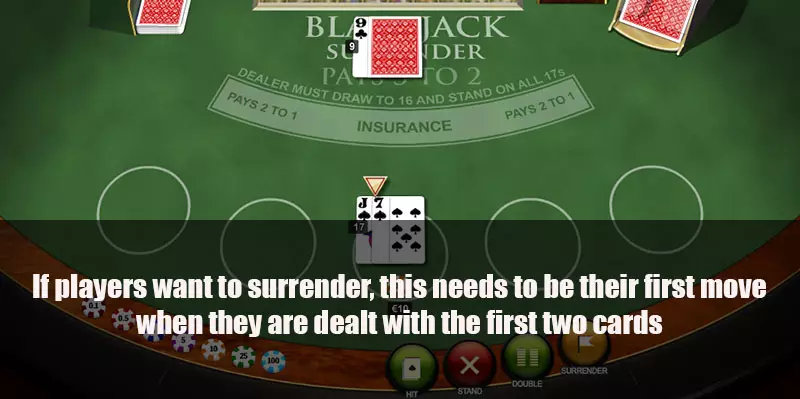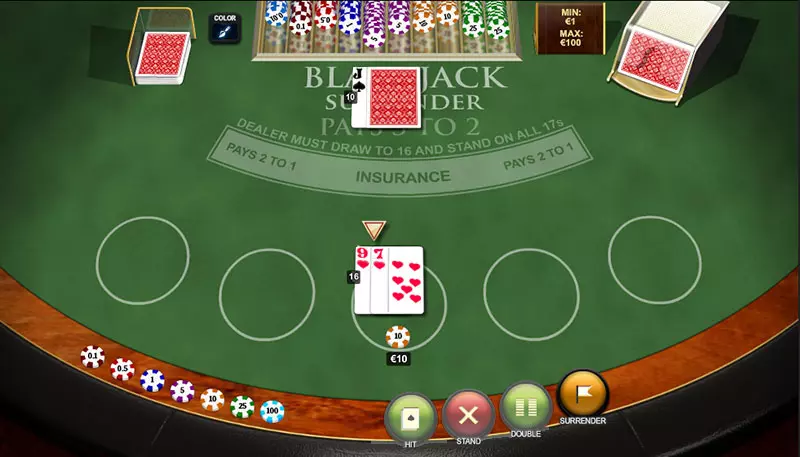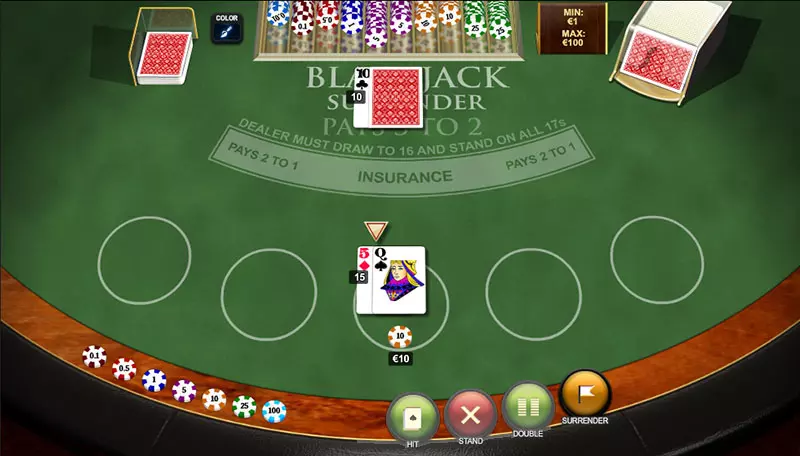It is no secret that the only way players can win at blackjack is to have the necessary knowledge and preparation. The game requires a great deal of skill and personal qualities such as discipline, but it really pays off for players who dedicate themselves to acquiring everything it takes to win. Blackjack offers four basic moves – hit, stand, split or double down – and one optional move: surrender.
This move is optional because not every casino offers it, and the reason for this is that it gives patrons a huge advantage over the casino if they are wise enough to use it in the appropriate situation. The fact that some places simply do not allow players to surrender is an indicator in itself that this option is beneficial for players.
In fact, it is advisable to ask the dealer or floor staff whether surrender is available before you sit down at a table. Even if surrender is permitted, it is rarely advertised or included on the plaques displaying the table rules.
What Is Surrender
Surrender is a blackjack term whose meaning players can easily guess. When gamblers surrender, they receive half of their stake back and the casino keeps the other half. The players are finished with that hand and do not play it further.
Gamblers can benefit greatly from this move when they know they are likely to lose the hand. It gives gamblers the chance to recover some of their money in situations where they are bound to lose. For this reason, it is advisable to seek out casinos that offer this option.
There are two variations of this rule. Originally, when this play was introduced in the early 1980s in Atlantic City, casinos offered early surrender. This meant that players could forfeit their hand and retrieve half of their wager before the dealer checked for blackjack when starting with a ten-value card or an ace.
It considerably decreased the house edge, leading to a significant drop in the profits Atlantic City casinos generated from their blackjack tables during the first five months of 1981, when early surrender was introduced.
It did not take casino operators long to realise this, which explains why early surrender was discontinued shortly after its introduction. Sadly, this option has become almost obsolete these days, although you can still find it in some online variations of blackjack.
As for the precise figures, early surrendering versus the dealer’s ace decreases the house edge by 0.39%, whereas early surrender against a ten-value card leads to a 0.24% drop in the casino’s advantage. Overall, the combined reduction amounts to a staggering 0.63%. This can completely wipe out the house edge provided the rest of the playing conditions are also favourable to the player.
Late surrender is far more common than its early predecessor. Under this rule, players still have the option to throw away a bad hand but can do so only after the dealer has peeked for blackjack. Needless to say, a player who does not hold blackjack automatically loses against the dealer’s natural, and late surrender is no longer possible. While still favourable to the player, late surrender reduces the casino’s edge by only 0.07% to 0.09%.
Although surrender is not a common option, some blackjack tables feature different variations of it, including:
- Early Surrender vs. 10 – this variation is available only when there is no hole card. Under it, players can surrender if the dealer has blackjack and the upcard is a ten.
- Surrender any number of cards – this rule benefits blackjack devotees, who can surrender a hand regardless of the number of draws.
- Surrender after Double – also referred to as Double Down Rescue, it provides players with the opportunity to surrender even after they have doubled down.
- Surrender after buying insurance – some casinos allow blackjack players to surrender a hand that they have already insured.
- Surrender after Splitting – you can surrender a hand after splitting. It is important to mention that players can still play the second hand.
How to Surrender
As with any other move, players need to know how to indicate it. Unlike with other moves, there is no universally accepted gesture or sign players can use. The most common way to surrender is by simply announcing it out loud. Before doing so, players must be certain that this is their final decision and that they really wish to withdraw from the current hand.
There is no need to worry about hand signals if you play blackjack exclusively online. However, it is worthwhile mentioning that some land-based casinos have introduced hand gestures for late surrender.
These may differ between casinos, but the most common gesture is to draw an imaginary horizontal line behind your betting box with your index finger. The gesture looks as if the player is cutting their wager in half, which they practically are.
It is advisable to accompany this gesture with a verbal declaration because many break-in dealers are in the habit of mistaking it for hitting. The second most common way to surrender is to hold both hands up as if admitting defeat. Either way, it is best to be safe and announce your intention to give up verbally.
It is also worth mentioning that if players wish to surrender, it must be their first move after they have received their initial two cards. If players have already split, doubled down or hit, they will not be allowed to surrender.

When to Surrender
It is appropriate to surrender whenever players find themselves in a situation where they are likely to lose the hand. Many gamblers avoid doing so even when they have the option, as the move is often criticised. However, seasoned players know that this move allows them to recover some of their money in a situation where they are otherwise certain to lose it all if they continue playing.
Surrendering is a wise decision so long as it is used only when players are really in trouble and their odds are unfavourable. Even though in such cases gamblers forfeit half of their bet without playing the hand, if it is a hand that guarantees a certain loss, it is best to recover some of their money.
Basic strategy typically favours surrendering stiff hands that do not fare well against a dealer’s strong upcards such as 9, 10, J, Q, K and ace. When you choose to forfeit a hand, you give up half of your bet.
That is why surrendering is largely optimal whenever the player holds a hand whose probability of losing is over 50%. This leads to a long-term reduction in losses when players find themselves in highly disadvantageous situations. This is usually the case when one is dealt stiff hands like 15, 16, and even 14 versus high dealer upcards in some single-deck games.
Optimal surrendering is influenced by the house rules for the dealer and how many decks are used, which calls for strategy adjustments when switching between blackjack variations. The basic strategy for surrendering in multi-deck blackjack differs from that in single-deck games, as you shall see shortly.
Blackjack Hand 14, 15 or 16
Surrender Rule
Blackjack Soft Hand 13 to 17
Blackjack Soft Hand 18
Blackjack Soft Hand 19 or 20
In Cases When Players Have Hand 16
To clarify the use of this move, let us consider one particular situation in which players are advised to take advantage of it. Consider the case where players end up with a hand totalling 16 and the dealer’s upcard is a jack. The odds are not favourable for the players; they are very likely to go bust or be outdrawn by the dealer.
For this reason, surrender is their best move, as it allows them to recover half of their initial bet, provided they are certain any other move would guarantee a loss.
Hard 16 is widely regarded as the worst possible hand in the game of 21. Things get especially tough when the player is up against a dealer who starts the round with a ten-value card, as is the case with Q-6 against a king.
There are three possible ways to play this hand. You can hit, stand, or surrender. Assuming you are playing a six-deck blackjack variation where the dealer stands on soft 17 (S17), the expectation of each of the three decisions is as shown below.
| EV of Hard 16 (Q-6) against the Dealer’s King in Six-Deck S17 Blackjack | ||
|---|---|---|
| Losses per £100 | ||
| Standing | -0.54043 | -£54.04 |
| Hitting | -0.539826 | -£53.98 |
| Surrendering | -0.5 | -£50.00 |
As becomes apparent, none of the three decisions can save you from incurring losses. If a player decides to stand on their Q-6 against the king, they will be outdrawn by the dealer often enough to suffer losses of approximately £54.04 for every £100 wagered on this hand.
Hitting reduces the player’s losses, albeit by a very small margin. The expected loss per £100 wagered decreases slightly to £53.98, which makes hitting the most optimal decision if surrendering the Q-6 is disallowed.
However, if late surrender is available, one should most definitely take advantage of it, as it reduces long-term losses to £50 for every £100 wagered on this stiff hand. So which is better: losing £54.04, £53.98 or £50 with your lousy hard 16? The answer is obvious.

In Cases When Players Have Hand 14 and 15
It is also recommended that players take advantage of the option to surrender when they have a hand totalling 14 or 15 – and, as already mentioned, 16 – and the dealer’s upcard is 9 through ace. The rationale is the same: the player’s odds of winning the hand are extremely unfavourable and it is best not to compound the problem by choosing to play it.
The basic strategy for surrendering in blackjack variants dealt out of four to eight decks changes a little based on whether your dealer must hit or stand on soft 17. In multi-deck S17 variants, surrender becomes optimal when you hold a hard 15 versus a 10 as well as when you have hard 16 versus dealers who expose 9, 10 and ace.

A stiff 16 that contains 8-8 requires another approach. The 8s are never surrendered in multi-deck S17 blackjack; they are always split. As for shoe-dealt blackjack where the dealer hits soft 17, the instances that call for surrender include a player 15 against the dealer’s 10 and ace, a hard 16 against 9, 10 and ace, hard 17 against an ace, and 8-8 versus an ace. Standing on hard 17 versus an ace becomes the second-best decision if surrender is disallowed. All these plays are summarised in the chart below.
| Surrender in Multi-Deck S17 Games | Surrender in Multi-Deck H17 Games | ||||||
|---|---|---|---|---|---|---|---|
| Hand Total | Dealer Upcard | Hand Total | Dealer Upcard | ||||
| 9 | K, Q, J, 10 | Ace | 9 | K, Q, J, 10 | Ace | ||
| Hard 14 | H | H | H | Hard 14 | H | H | H |
| Hard 15 | H | Rh | H | Hard 15 | H | Rh | Rh |
| Hard 16 | Rh | Rh | Rh | Hard 16 | Rh | Rh | Rh |
| Hard 17 | S | S | S | Hard 17 | S | S | Rs |
Many players wrongly believe that their hard 15 will hold up against the dealer and stubbornly refuse to surrender. In reality, this stiff hand is always inferior no matter what exposed card the dealer starts with.
The situation is worst when the player’s 15 is up against ten-value cards and aces. A two-card hard 15 against a 9 or an ace is still bad but does not call for surrendering since the losing percentages of the hand are under 50%, as you can see below.
| EV of Hard 15 against Dealer Upcards 9, 10, and Ace in Multi-Deck S17 Games | |||||
|---|---|---|---|---|---|
| Hard 15 vs. 9 | Hard 15 vs. 10 | Hard 15 vs. Ace | |||
| Standing | -0.54315 | Standing | -0.54043 | Standing | -0.666951 |
| Hitting | -0.471578 | Hitting | -0.504428 | Hitting | -0.480006 |
| Surrendering | -0.5 | Surrendering | -0.5 | Surrendering | -0.5 |
As for hard 14, this is never surrendered in multi-deck blackjack regardless of how many packs are in play and the dealer’s fixed rules. Instead, the player stands on their 14 against upcards 2 through 6 and hits the hand when the dealer holds 7 through ace. Paired 7-7 must be split in shoe games only versus 2 through 7, and hit against the rest of the upcards.
The situations in which surrender becomes the optimal play differ slightly in single-deck games. Whether or not the dealer hits soft 17 should also be considered. In single-deck S17 blackjack, you are advised to forfeit hard 16 when the dealer exposes a 10 or an ace. Pairs of 7-7 should be forfeited versus the 10. As for single-deck H17 games, surrendering is advisable with hard 15 and hard 17 against an ace, with hard 16 against 9 through ace, and with 7-7 against the 10 and the ace.
| Surrender in Multi-Deck S17 Games | Surrender in Multi-Deck H17 Games | ||||||
|---|---|---|---|---|---|---|---|
| Hand Total | Dealer Upcard | Hand Total | Dealer Upcard | ||||
| 9 | K, Q, J, 10 | Ace | 9 | K, Q, J, 10 | Ace | ||
| Hard 14 | H | H | H | Hard 14 | H | H | H |
| Hard 15 | H | H | H | Hard 15 | H | H | Rh |
| Hard 16 | H | Rh | Rh | Hard 16 | H | Rh | Rh |
| Hard 17 | S | S | S | Hard 17 | H | H | Rs |
| Paired 7-7 | H | Rs | H | Paired 7-7 | H | Rp | Rs |
Conclusion
There is no special formula in blackjack or any other casino game that guarantees players a 100% chance of winning; after all, this is gambling. However, if players want to increase their chances as much as possible, they need to strive to master the game and improve every day. This is the only way they can turn the tables and have favourable odds of leaving the casino as winners.
One of the most important things gamblers need to know thoroughly is the game’s basic rules and possible moves. Players who want to win need to understand that the only way to do so is to know how to proceed with every hand they are dealt.
There are many tough decisions to make, and if they do not follow a strategy and prepare beforehand, they stand little chance of winning the hand. Surrender is disallowed in some casinos precisely because it works in the player’s favour if used appropriately. Thus, gamblers need to make sure they know when and how they can take advantage of it.